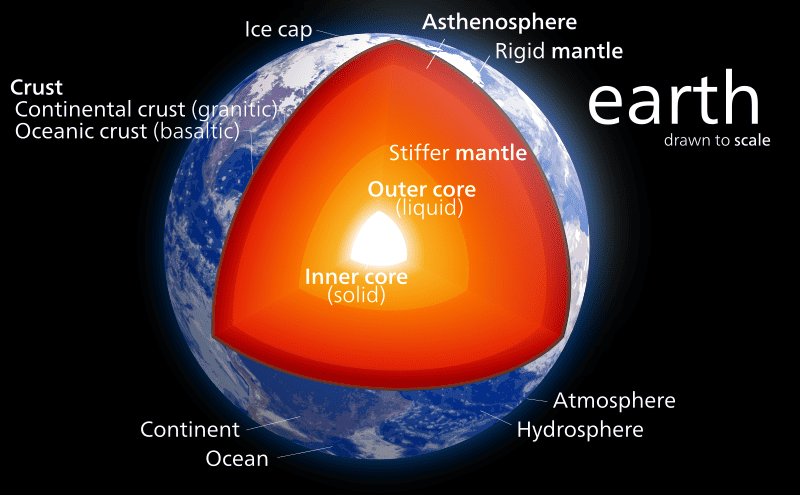
At the heart of our planet lies a mysterious, solid metal ball, a planet within a planet, that plays a crucial role in supporting life on Earth as we know it.
Scientists have long been intrigued by the formation and evolution of Earth’s inner core, and now a team of researchers from the University of Utah has made a striking discovery, revealing that this solid metal sphere is far from homogeneous. In fact, it’s a complex tapestry of different “fabrics,” shedding new light on the deep realms of our planet.
Unveiling the hidden depths and fabrics of planet Earth
Earth’s inner core, with a diameter of 2,442 kilometers (1,517 miles), accounts for less than 1% of the planet’s total volume. However, its significance is immeasurable. It is solely responsible for generating Earth’s magnetic field, a vital shield protecting us from harmful solar radiation.
Now, for the first time, scientists have confirmed the presence of inhomogeneity throughout the inner core, overturning the previous assumption that it was a uniform mass.
“This kind of inhomogeneity is everywhere inside the inner core,” says Guanning Pang, lead author of the study who completed this research as part of his Ph.D. dissertation at the University of Utah’s Department of Geology and Geophysics.
The inner core’s textured nature opens up a new frontier in our understanding of Earth’s deep interior. It has long been a challenge to investigate this hidden realm due to its inaccessibility. However, seismic waves from earthquakes provide a unique opportunity to probe the depths of our planet.
University seismologist Keith Koper, who oversaw the study, compares it to exploring a frontier area, where we must peel away the shallow effects to gain insight into the deepest part of the inner core.
From nukes to Earth’s innermost core

In their quest to unravel the properties of Earth’s inner core, the research team utilized a special dataset generated by a global network of seismic arrays designed to detect nuclear blasts. Established in 1996, the International Monitoring System (IMS) of the Preparatory Commission for the Comprehensive Nuclear-Test-Ban Treaty Organization (CTBTO) serves to enforce the international ban on nuclear detonations.
If a nuke blows up anywhere across the world, either below or above ground, scientists will know about it. But this network not only detects explosions but also provides a wealth of data that scientists can use to investigate Earth’s interior. When seismic waves travel through Earth’s layers and finally hit a detector at the surface, these echoes can be decoded to reveal information about all the materials through which they passed or that they bounced off of.
The seismic data collected by these arrays have led to numerous scientific breakthroughs, from identifying meteor blasts and identifying marine life to advancing weather prediction and enhancing our understanding of iceberg formation.
Earth’s core, with a diameter of about 6,900 kilometers (4,300 miles), primarily consists of iron, with some nickel and other elements. The outer core envelops the solid inner core, remaining in a liquid state. Koper describes it as a “planet within a planet” that has its own rotation, distinct from the outer layers.
The liquid outer core, through convection, generates a protective magnetic field that extends 2,260 kilometers (1,795 miles) above the solid core. This convection process involves the rising of molten iron, cooling near the rocky mantle, and sinking back down. The resulting circulation generates the bands of electrons enveloping the planet.
Without the solid inner core, this magnetic field would be much weaker, exposing the planet’s surface to radiation and solar winds that could strip away the atmosphere, rendering it uninhabitable.
Though Earth’s iron-rich core is subjected to dizzying temperatures in excess of 5,427 °C (9,800 °F), it stays solid. This has always been a mystery for geologists and geophysicists. As it turns out, it is unlikely that this innermost core is solid throughout.
A deeper understanding
Koper’s lab had been diligently studying seismic data pertaining to the inner core for several years. In a previous study led by Pang, the researchers identified variations in the rotations of Earth and its inner core. These variations were so significant they may have influenced the length of a day during the years 2001 to 2003.
For their recent study, the team examined seismic data from 2,455 earthquakes, all of which exceeded a magnitude of 5.7. These seismic waves, bouncing off the inner core, provided valuable insights into its internal structure. However, detecting these minute signals proved to be an immense challenge.
“This signal that comes back from the inner core is really tiny. The size is about on the order of a nanometer,” Koper said. “What we’re doing is looking for a needle in a haystack. So these baby echoes and reflections are very hard to see.”
The solidification of Earth’s inner core began at some point in its history under the extreme pressures found at the center of the planet. Although the exact initiation time remains a mystery, the seismic data analyzed by the research team has offered important clues.
A scattering effect observed in waves that penetrated the core’s interior indicated the presence of inhomogeneity. Remarkably, this texture appears to be stronger toward the center of the Earth, suggesting that the inhomogeneity is related to the inner core’s growth.
According to scientists, Earth’s inner core grows by about a millimeter each year as the liquid outer core solidifies at the boundary with the inner core. But some of this liquid material may have migrated deeper into the inner core, where it became trapped.
“We think that this fabric is related to how fast the inner core was growing. A long time ago, the inner core grew really fast. It reached an equilibrium, and then it started to grow much more slowly. Not all of the iron became solid, so some liquid iron could be trapped inside,” Pang explains.
The discovery of the inner core’s texture challenges the traditional view of a uniform, solid metal sphere at the heart of our planet. Instead, it reveals a complex and dynamic structure, akin to a tapestry of different materials. This newfound understanding paves the way for further investigations into Earth’s interior and its evolution over time. By deciphering the inner core’s secrets, scientists can unravel the intricate processes that have shaped our planet and continue to influence its magnetic field and overall habitability.
As researchers peer deeper into Earth’s inner core, the mysteries of our planet unfold, showcasing the awe-inspiring complexity hidden beneath our feet. Thanks to seismic waves and the diligent efforts of scientists, we can piece together the puzzle of Earth’s inner core, gaining profound insight into the forces that shape our world.
The findings appeared in the journal Nature.






